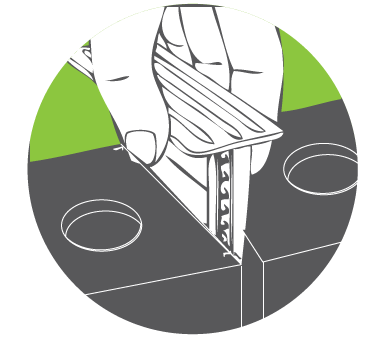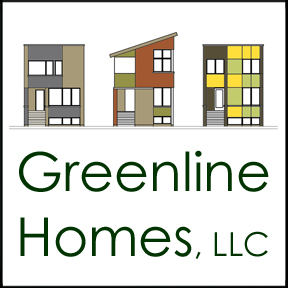
RESPONSIBLE USE OF NATURAL RESOURCES
FSC Certified Wood
Nearly all wood products in our homes (framing lumber, trim and doors, flooring, etc.) have been sourced from North America and certified through the Forest Stewardship Council (FSC). FSC is the most rigorous, credible forest certification system and is accepted as the gold standard in ensuring wood has been harvested in a sustainable manner to minimize long-term impact on the forest environment.

RADON VENTING
Soil gas prevention and peace of mind
Although we do not anticipate a soil gas problem, we have provided the area under the basement floor and around the foundation with a clear vented path up and through the roof to allow any soil gases to escape to the outside above the home without entering the home itself. An electrical box has also been placed in the roof cavity in case a suction fan would ever have to be added.

HIGH PERFORMANCE HOME WRAP
Your home needs a protective skin just like you do
Our "housewrap" is a "water-resistive vapor-permeable air barrier membrane." By carefully installing this home's "skin," we control the flow of air and moisture through the exterior of the building and greatly reduce the potential for problems such as air infiltration, water damage, rot, and mold growth. Other benefits include improved energy efficiency and indoor air quality over the life of the building.

BRICK VENTS
Like a rain-screen for masonry walls
Much of the water penetration through brick and cast stone walls is caused not by driving wind and rain on the exterior face of the wall but by the suction created within the air cavity by the lower interior air pressure. This force is controlled by installing brick vents in sufficient frequency and size to allow almost immediate air pressure equalization. Since winds gust, rather than create steady pressure, vents must have enough opening area to allow a continuous exchange of air. A masonry wall that dries to the outside means water stays outside your home.

INSULATED FOUNDATION & BASEMENT FLOOR
A drier, more comfortable basement
This home's foundation and basement floor slab is fully insulated on all sides with rigid XPS foam. The heat loss from an uninsulated, conditioned basement may represent up to 50% of total heat loss in an otherwise well-insulated house and makes the basement feel cold and damp. In addition to reducing heating costs, foundation insulation increases comfort, reduces the potential for condensation and corresponding growth of mold, and increases the livability of below-grade rooms.

DESIGNED ON A 2' MODULE
Efficient use of materials and less waste
Designing a home on a 2' module means making room dimensions and the overall measurements of a home some multiple of 2'. Construction materials normally come in some multiple of 2' (an 8' long 2x4 or a 4'x8' sheet of plywood for example) and if a house were built with walls 42' long then the builder would have to use 5 sheets of plywood and throw away most of the last sheet. This home is designed on a 2' module to use plywood, dimensional lumber, drywall, interior trim, siding, and even flooring in the most efficient way possible and reduce cost and waste.

ADVANCED FRAMING TECHNIQUES
Optimum value engineering
With the goal of a more comfortable and energy-efficient home, Advanced Framing {also called optimum value engineering) reduces the amount of structurally-redundant lumber in the walls to save natural resources and allow for more insulation. It also places structural members in a way that allows for a maximized thermal break between the indoors and outdoors. Homes built with Advanced Framing techniques will be more energy-efficient because of the increased insulation and have a lower impact on the environment by saving unnecessary lumber.

LADDER BLOCKING
An advanced framing technique
In conventionally framed walls where an interior partition wall meets an exterior wall, two or three full-length studs are used. The advanced framing ladder junction method eliminates the need for these studs, reduces the amount of lumber used, and preserves an exterior wall cavity that can be insulated.

STAGGERED-STUD WALLS
An advanced framing technique
Traditionally framed houses lose a lot of energy through the vertical wall studs that hold up the floors and roof. Staggering the studs in our exterior wall allows us to have an uninterrupted path for insulation through a much larger portion of the wall than a conventionally built house. Building our exterior walls with this technique will make this home more energy efficient, quieter, and more comfortable.

THERMALLY BROKEN EXTERIOR WALL
Continuous insulation is more effective
Full-masonry houses lose a lot of energy through exterior wall studs that, in traditional construction, are nailed against masonry walls. We leave a gap between our exterior wall studs and the masonry walls to create an uninterrupted path for insulation against the masonry walls. This is a cost-effective and structurally-sound method to create more energy efficient, quieter, and more comfortable masonry homes.

GRAB BAR BLOCKING
Planning for aging in place
An adaptable home is a durable home, and durability is a key element of a green home. Adding blocking in baths for future grab-bar installation is easy to do and saves on future renovation costs.

WATER SENSE FIXTURES
Water-efficient, yet fully functional
WaterSense® is a labeling program by the US Environmental Protection Agency that ensures labeled fixtures are water efficient to a rigorous standard. Our toilets and bath faucets are all WaterSense® rated to have a comfortable flow but still use less water than old fixtures.












